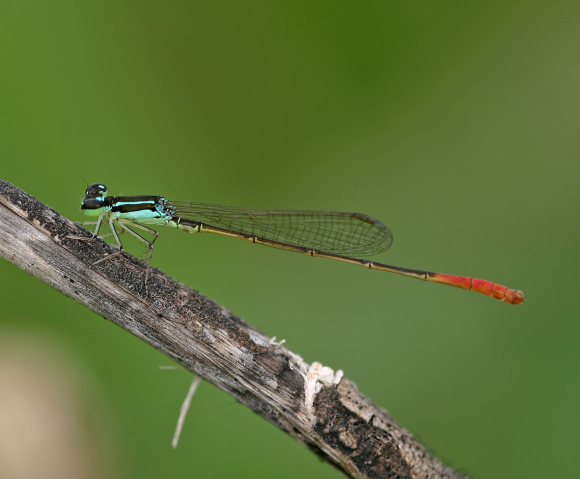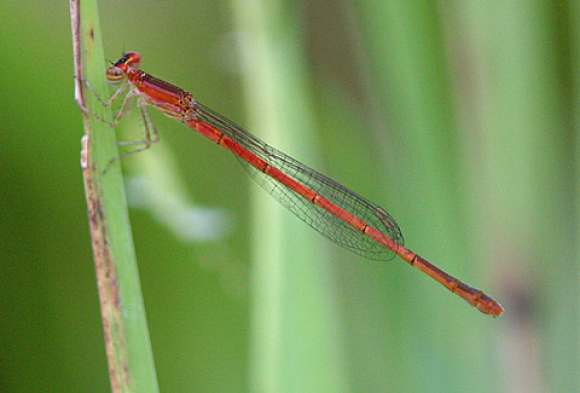Genus Agriocnemis Selys, 1877
wisps
Synonyms:
- scientific: Mortonagrion sensu Schouteden, 1934 nec Fraser, 1920
Type species: Agrion pygmaeum Rambur, 1842
Introduction
Genus occurs from Africa to Australia and the Pacific with over 40 species, almost half of them African. They are very small (hindwing 8-16 mm), including the tiniest African odonates. Most species live among dense slender vegetation standing in water, such as grass growing in temporary pools or along calm rivers. Because of their size and habitat they are easily overlooked: sweeping a net through stands of sedges and grasses is the best way to find them. Indeed, some species may have been overlooked altogether. For example, A. bumhilli, A. canuango and A. toto were discovered very recently, the latter two within only half a kilometre of each other in bogs in northern Angola. A. exilis can be found at almost any grassy wet patch in tropical Africa, but many species require larger marsh habitats. In extensive areas of suitable habitat, such as at the Okavango, up to five species occur together. Four species are largely tied to pools and swamps in or near forest, A. forcipata in more exposed and A. maclachlani in more shaded spots, while A. stygia is typical of flooded forests where it perches rather openly on twigs over shaded water, and A. angustirami is localised in West Africa, possibly especially near mangroves. Note that A. forcipata may occur with the extremely similar, but much wider-ranging, A. victoria. Among African odonates A. palaeforma is unique in being associated with the most African of aquatic plants: still known only from papyrus swamps in Uganda, it may be much overlooked due to its impenetrable habitat. The species exhibit strong variation in coloration, depending on sex and age. Males of most species have a diagnostic reddish tail-end (typically abdominal segments 8-10 and part of 7) and are otherwise largely black with green (sometimes blue) markings. Fresh ones, however, may have all-red abdomen and blue-marked head and thorax. Some old males blacken entirely and develop white pruinosity on head, thorax and/or abdomen. For example, black A. maclachlani males stand out in the gloom by their all-white thorax, while A. zerafica may become quite evenly grey pruinose overall. In A. ruberrima this type of variation may be fixed geographically: populations in north-eastern South Africa (known as subspecies ruberrima) have black on the orange-red abdomen only on the dorsum of abdominal segments 1-2 and base of 3. In northern Botswana and north-eastern Namibia (subspecies albifrons) the black extends to abdominal segment 7 and also the frons becomes whitish pruinose with maturity, while the even blacker population at Lake Bangweulu (Zambia) even has the thorax entirely pruinose. Although potentially difficult to examine in such small damselflies, appendages are essential for identification: no African genus demonstrates such diversity in their structure as Agriocnemis. We treat the rather distinct Mortonagrion stygium in Agriocnemis. [Adapted from Dijkstra & Clausnitzer 2014]
Diagnosis
Males of genus are easily separated from other coenagrionoids by (1) small size, Hw 8-16 mm; (2) Fw quadrilateral with anterior and distal border about equal in length; (3) arculus stands distal to Ax2 by about its own length. [Adapted from Dijkstra & Clausnitzer 2014]

Agriocnemis palaeforma Pinhey, 1959. Male © Hans-Joachim Clausnitzer

Agriocnemis falcifera Pinhey, 1959. © Warwick Tarboton
Map citation: Clausnitzer, V., K.-D.B. Dijkstra, R. Koch, J.-P. Boudot, W.R.T. Darwall, J. Kipping, B. Samraoui, M.J. Samways, J.P. Simaika & F. Suhling, 2012. Focus on African Freshwaters: hotspots of dragonfly diversity and conservation concern. Frontiers in Ecology and the Environment 10: 129-134.
References
- Pinhey, E. (1974). A revision of the African Agriocnemis Sélys and Mortonagrion Fraser (Odonata: Coenagrionidae). Occasional Papers of the National Museums & Monuments of Rhodesia. Natural Sciences, 5, 171-278. [PDF file]
- Dijkstra, K.-D.B. (2007). The name-bearing types of Odonata held in the Natural History Museum of Zimbabwe, with systematic notes on Afrotropical taxa. Part 1: introduction and Anisoptera. International Journal of Odonatology, 10, 137-170. [PDF file]
- Dijkstra, K.-D.B. (in prep.) Odonata of the Congo: checklist, bibliography, gazetteer, new records, species descriptions, and taxonomic notes with an emphasis on Elattoneura, Mesocnemis and Congothemis. Zoologische Mededelingen. [PDF file]
- Ris, F. (1921). The Odonata or Dragonflies of South Africa. Annals South African Museum, XVIII, 245-452. [PDF file]
- Balinsky, B. I. (1963) A contribution towards the systematics of dragonflies of southern Africa (Odonata). Journal Entomological Society Southern Africa 26 (1): 228-255 [PDF file]
- Pinhey, E.C.G. (1961). Dragonflies (Odonata) of Central Africa. Occasional Papers Rhodes-Livingstone Museum, 14, 1-97. [PDF file]
- Pinhey, E.C.G. (1962). New or little-known dragonflies (Odonata) of Central and Southern Africa. Occasional Papers National Museum Southern Rhodesia, 26, 892-911. [PDF file]
- Pinhey, E.C.G. (1967). Odonata Zygoptera. Exploration Hydrobiologique Bassin Lac Bangweolo Luapula, 14, 1-43. [PDF file]
- Schouteden, H. (1934) Annales Musee Congo belge Zoologie 3 Section 2 3 (1): 1-84 [PDF file]
- Schmidt, E. (1951). Libellen aus Portugiesisch Guinea, mit Bemerkungen über andere aethiopische Odonaten. Arquivos Museu Bocage, 20, 125-200. [PDF file]
Citation: Dijkstra, K.-D.B (editor). African Dragonflies and Damselflies Online. http://addo.adu.org.za/ [2024-10-30].

